Material Collection
Straw Products
Using straw as a building material is an excellent option for natural, carbon-storing construction. Straw is an agricultural byproduct from the production of cereal grains. It can take the form of various building products such as straw bales, prefabricated panels, blown insulation, or compressed boards.
A wall system made of straw insulation, surfaced with clay and lime plasters, effectively manages moisture in walls. This wall system naturally regulates humidity and heat, is breathable and energy-efficient. Due to its low nutrient content, straw is resistant to pests, and its high silica content acts as a natural fire retardant. The use of straw in construction not only repurposes waste from food production but also promotes the regional development of biobased materials sourced from local feedstocks.
Below are a few examples of straw products that meet our rigorous evaluation. For further assistance on building with straw, please refer to the "Spec Guidance" section.
Straw Products
6 products
About Our Collections
The goal of our collections is to help promote transparency in the material ingredients of building products by fostering knowledge and awareness of products and materials for which life-cycle information is available, and that have environmentally, economically, and socially preferable life-cycle impacts.
Keep an eye out for the following symbols:
A Healthier Affordable Building Product
Products with the designation of "Healthier & Affordable" were specified and installed in at least one of our Case Studies of healthier affordable housing.
Available at the Donghia healthier Materials Library
The Donghia healthier Materials Library library is open to Parsons student and faculty. Learn more about access and opening hours here.
Low Embodied Carbon
“Embodied Carbon” is the total amount of carbon emitted during the process of making a material. *HML refers to a manufacturer's EPD to determine whether a product's A1-A3 carbon emissions falls within HML's threshold for Low Embodied Carbon.
New Product
This product has been added to the collection within the past six months.
Product in Development
Products with this designation identify they are currently scaling or only available in markets outside of the building industry. they could be experimental or in use in capsule collections.
Available in the EU
Products with this designation are currently available only in the European Union and identified as being an exemplary healthy option in the respective product group.
Ingredient Disclosures
There are several ways of evaluating a material’s health that we include with product information. Disclosures are reports by manufacturers about product ingredients, impacts, or other attributes.
Key Disclosures include:
Health Product Declaration (HPD)
A voluntary technical specification for reporting information on product contents and associated health information, intended to be the health-analogue to Environmental Product Declarations (EPDs).
Declare Label
Declare is a transparency platform and product database that answers three questions:
1. Where does a product come from?
2. What is it made of?
3. Where does it go at the end of its life?
Environmental Product Declaration (EPD)
A standardized format for communicating the environmental effects associated with a product’s raw materials extraction, energy use, chemical makeup, waste generation, and emissions to air, soil, and water.
Safety Data Sheet (SDS)
A reporting format that provides basic information about a material’s chemical ingredients, the potential safety hazards to installers, and recommended practices for installation.
USDA Certified Biobased Product Label
Managed by the U.S. Department of Agriculture (USDA), the goal of the BioPreferred Program is to increase the purchase and use of biobased products.
Other
| Manufacturer | Product | Ingredient Disclosures |
|---|---|---|
| New Frameworks | Straw Bale Walls |
Straw Bale WallsNew Frameworks build prefabricated structural straw panels. The wheat straw is locally sourced from a certified organic farm by NOFA-VT and densely packed at 9lbs/cu.ft. A clay/lime plaster as interior air barrier is a preferable solution. Different air sealing methods can be applied to exteriors, opt for plywood or other options free from petrochemicals. The R-Value is 1.8/inch. CategoryWall Panel, StrawManufacturerNew Frameworks
Material composition*Wheat Straw, CDX plywood *as reported by the manufacturer CERTIFICATIONS & DISCLOSURES
Health Product Declaration (HPD)
Declare Label
Environmental Product Declaration (EPD)
Safety Data Sheet (SDS)
USDA Certified Biobased Product Label
Other
Last UpdatedMay 13, 2024 |
| Croft | Straw Panel Assemblies |
Straw Panel AssembliesCroft designs straw-based wall, floor, and roof panels for pre-fabricated assemblies based in Maine. They aim to source straw from organic farms when possible. Plywood is sourced from Roseburg and timber is FSC-certified. Note: Roseburg plywood contains 3-5% phenol formaldyehyde resin, a comparably lower content. CategoryWall Panel, StrawManufacturerCroft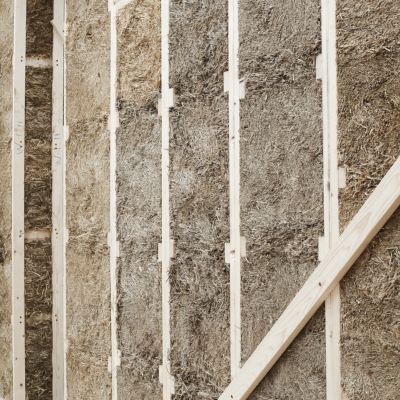
Material composition*Straw, Timber, Plywood (3-5% phenol formaldyehyde resin) *as reported by the manufacturer CERTIFICATIONS & DISCLOSURES
Health Product Declaration (HPD)
Declare Label
Environmental Product Declaration (EPD)
Safety Data Sheet (SDS)
USDA Certified Biobased Product Label
Other
Last UpdatedApril 29, 2024 |
| EcoCocon |
Timber-Straw Panel
|
Timber-Straw PanelAvailable At the Donghia Materials LibraryAvailable in the EUEcococon's Wall Panel is made of straw and timber that is condensed per a special straw pressing technique. The result is a product used for wall sheathing. In combination with the appropriate wall finishes, this wallboard panel is Passivhaus certified. Note: The plywood binder contains a phenol-formaldehyde-based resin. The plywood is FSC Certified Chain of Custody. CategoryWall Panel, StrawManufacturerEcoCocon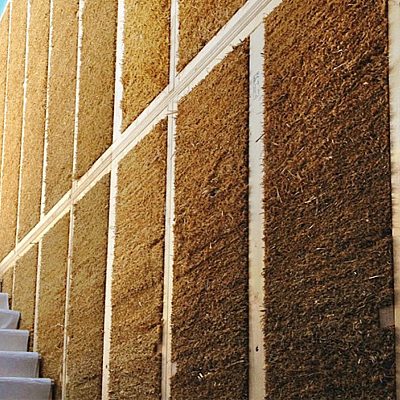
Material composition*98% straw and timber *as reported by the manufacturer AVAILABLE SIZINGStandard thickness 15.7" CERTIFICATIONS & DISCLOSURES
Health Product Declaration (HPD)
Declare Label
Environmental Product Declaration (EPD)
Safety Data Sheet (SDS)
USDA Certified Biobased Product Label
Other
Cradle to Cradle | Silver
PassivHaus
FSC | Mix
Last UpdatedDecember 16, 2025 |
| IStraw |
Blown Straw Insulation
|
Blown Straw InsulationAvailable in the EUIStraw creates a blown-in insulation from 100% straw for roof, exterior walls, ceiling, partitations and insulation. Their ELITE GREENLINE series is confirmed to have no pesticide residues from farming. The straw is compostable after its useful life. Located in Germany, IStraw has developed a building network to connect local farmers and suppliers. CategoryLoose Fill, StrawManufacturerIStraw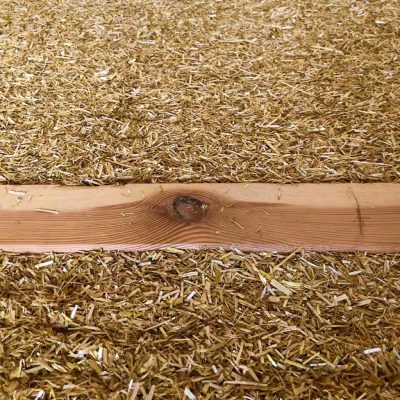
Material composition*100% Straw *as reported by the manufacturer CERTIFICATIONS & DISCLOSURES
Health Product Declaration (HPD)
Declare Label
Environmental Product Declaration (EPD)
Safety Data Sheet (SDS)
USDA Certified Biobased Product Label
Other
Last UpdatedJanuary 30, 2025 |
| Savick | Straw Assemblies |
Straw AssembliesSavick creates roof, flooring and wall assemblies from locally sourced wheat and barley straw in Canada. Straw gets chopped up and densly packed (90 kg per cubic meter). This density and the high silica content in wheat acts as natural flame retardant. Savick carpenters assemble the wood frames from FSC certified wood and plywood. The R-Value is approx. 3.1/inch. Note: The plywood binder is unknown. CategoryWall Panel, StrawManufacturerSavick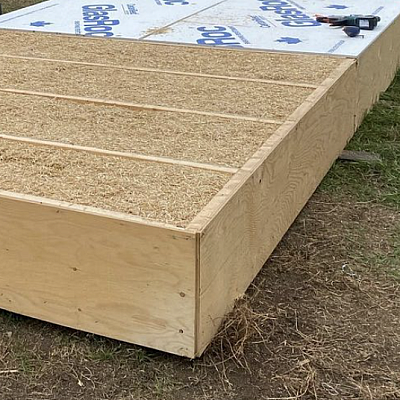
Material composition*Wheat and Barley Straw, Wood, Plywood *as reported by the manufacturer CERTIFICATIONS & DISCLOSURES
Health Product Declaration (HPD)
Declare Label
Environmental Product Declaration (EPD)
Safety Data Sheet (SDS)
USDA Certified Biobased Product Label
Other
Last UpdatedApril 26, 2024 |
| Agriboard |
Compressed Agricultural Fiber Board
|
Compressed Agricultural Fiber BoardProduct in DevelopmentCompressed Agricultural Fiber Boards (CAF boards) are made with a patented mill technology for affordable, large scale straw assemblies. The straw is locally sourced with no added binders or adhesives. They use H-steel framing and obtain structural integrity from densely pressed straw. Note: 1% borate is to prohibit mildew. CategoryWall Panel, StrawManufacturerAgriboard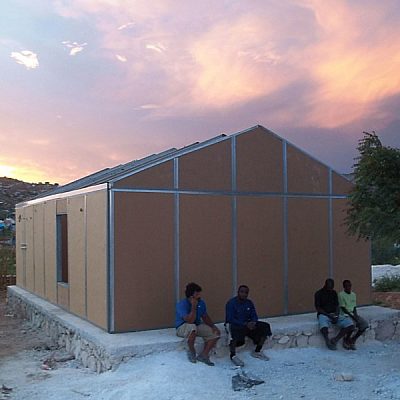
Material composition*96% Agricultural Straw (wheat or rice), 3% Kraft paper, 1% Borate *as reported by the manufacturer AVAILABLE SIZINGSpan width can be 4ft. CERTIFICATIONS & DISCLOSURES
Health Product Declaration (HPD)
Declare Label
Environmental Product Declaration (EPD)
Safety Data Sheet (SDS)
USDA Certified Biobased Product Label
Other
Last UpdatedAugust 05, 2025 |
The products in this collection have all been evaluated holistically for their contents and performance. To be considered, the product must have a primary ingredient (by volume) that is derived or harvested from straw avoiding additives and pesticides harmful to human and planet. Procurement should prioritize products made with local materials.
*Glyphosate is a known carcinogen commonly applied as a pesticide to crops in the US.
All products are evaluated for embodied carbon {kg of CO₂ eq /square meter) if (LCA) and (EPD) documentation is available. Those under 5 kg of CO₂ equivalent per square meter earn the HML Standard for Low Embodied Carbon (LEC) and are clearly marked.
Spec Guidance
Inquire with manufacturers for transparency and LCA information as much as possible. Materials new to the market may not yet have certifications and disclosures and often are made proprietarily.
When sourcing straw, look for local agricultural crops. Wheat, rice, barley, oats, rye, or other locally available cereal grains are viable plants for straw.
Rice straw has high silica content, making it inherently fire retardant and eliminating the need for added toxic flame retardant chemicals. Flax straw is rot resistant.
Opt for sources from local farms practicing low-pesticide*, no-till, regenerative agriculture.
Monitor moisture content in bales to stay below 18 - 25% dry basis (20% wet basis) through plastering and air-tight detailing. Before installation, test moisture levels in the bale core using a moisture probe.
Sun-dried straw bales are preferable as sun drying reduces the nitrogen content in the straw. Green in the straw indicates a higher nitrogen level. Lower nitrogen levels impedes composting /degradation.
Consult and collaborate with local natural builders for expertise and best practices. Knowledgeable local builders are often the best resources.
Updated April 25, 2024
Join Our Academic Network
Get Access to our carefully researched and curated academic resources, including model syllabi and webinars. An email from an academic institution or a .edu email address is required. If your academic institution does not use .edu email addresses but you would like to join the network, please contact healthymaterialslab@newschool.edu.
Already have an account? Log in